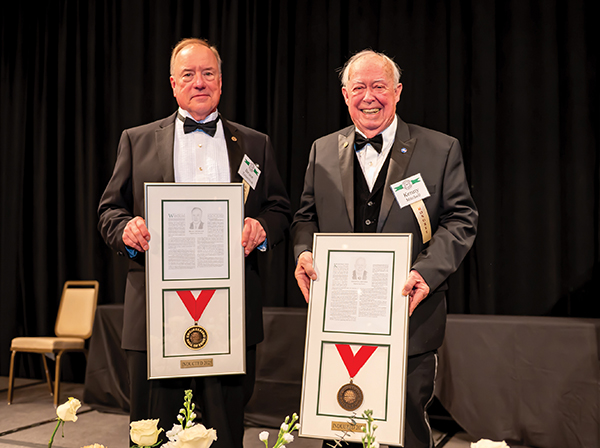
The State of Alabama Engineering Hall of Fame inducted eight individuals — including one Auburn University alumnus and an Auburn chemical engineering professor — and one corporation during a ceremony Feb. 22 at the Renaissance Birmingham at Ross Bridge.
Class of 2025 inductees associated with the university included Kenny Mitchell, ’65 mechanical engineering, and Bruce Tatarchuk, the Charles E. Gavin III Chair of chemical engineering.
Class of 2025
Kenny Mitchell ’65 / Mechanical Engineering
Kenny Mitchell earned his bachelor’s degree in mechanical engineering in 1965. Upon graduation, he went to work at the Marshall Space Flight Center under Wernher von Braun, contributing to the monumental goal of putting the first humans on the moon. He was an engineer on Saturn I — the first U.S. medium-lift launch vehicle to send payloads of up to 20,000 pounds into low Earth orbit. This was followed by Saturn IB, which increased payloads to 35,000 pounds, setting the stage for Saturn V, which put men on the moon in 1969. One of Mitchell’s key responsibilities at Marshall was ensuring the Saturn V did not explode during launch or reentry. His expertise in thermal control systems led to the development of heat shields capable of withstanding the high temperatures faced during these critical phases. Following his work on the Saturn V, Mitchell contributed to the Skylab program — America’s first space station and the first crewed research laboratory in space.
His efforts were instrumental in designing a passive habitable system that allowed astronauts to work in extreme environments. He also worked on the thermal control systems for the Apollo Telescope Mount, the most powerful solar telescope in orbit during the 1970s.
His next major project was Spacelab, a reusable space laboratory flown by the space shuttle in collaboration with the European Space Agency, where he served as environmental control life support system branch chief.
In his final years at NASA, Mitchell served as the project manager for all of the Italian Space Agency, which provided modules on the International Space Station that were critical to logistics supply and docking ports for visiting vehicles. Mitchell’s last act at NASA was as the deputy program manager for the Discovery and New Frontiers Program, working on solar system exploration.
Bruce Tatarchuk Professor / Mechanical Engineering
Bruce Tatarchuk graduated from the University of Illinois in 1981 with a bachelor’s degree in chemical engineering and went on to earn his doctorate in the same discipline from the University of Wisconsin. He began his career in 1982 at Auburn University as an assistant professor and currently serves as the Charles E. Gavin III Chair of chemical engineering and director of the Center for Microfibrous Materials Manufacturing.
Tatarchuk’s engineering career includes the development and commercialization of technology that can be found on virtually every aircraft flying within the U.S. and Europe. He is a widely recognized expert in heterogeneous reactive systems and process intensification and has been the principal investigator on more than $70 million of competitively awarded extramural research contracts to Auburn University and double that amount as a co-investigator. His pioneering work in new materials has seen applications in various fields, from catalysis to energy storage. In addition, he has an extensive publication and presentation record which includes more than 300 peer-reviewed articles, numerous reviewed proceedings and technical abstracts, four book chapters, 110 invited and plenary lectures and more than 600 technical presentations to esteemed societies in the U.S. and abroad.
Tatarchuk and his Auburn University team are widely recognized for the new class of high performance structured chemical reactor materials based on the microfibrous entrapment of highly reactive solids allowing them to operate chemical reactors at much higher steady-state volumetric rates than any group or technology in the world. Their work has inspired companion applications and impact opportunities for a variety of battery and electrochemical systems.
Today, Tatarchuk’s company — IntraMicron — is one of only five global producers of micron diameter metal fibers. The patent portfolio in IntraMicron technology was formally recognized in 2014 with his induction as a fellow in the National Academy of Inventors.
For his achievements, he received the 2016 Auburn University Research Advisory Board Advancement of Research and Scholarship Achievement Award, the 2015 SEC Auburn University Faculty Achievement Award, the 2014 Auburn University Excellence in Innovation Award, the 2006 and 1999 Auburn Engineering Senior Research Award for Excellence, the 2003 Auburn University Creative Research Award, the Fluor Corporation Young Faculty Award from 1984-88 and the Olin Research Award for work in Heterogeneous Catalysis and Surface Chemistry in 1975.